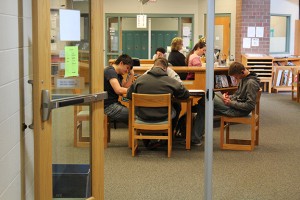Diploma Discussion: How Will Added Credits Affect Counselors?
Indiana policymakers are focusing a lot of their attention lately on the different diploma options offered to Hoosier high school students. After the original draft for new choices came down from a committee of educators and business leaders, members of the public had a lot to say about he proposed changes – so much so that the State Board of Education decided to send them back to the drawing board. Over the next two weeks, we’re taking a deep dive into some of the ideas that have been brought forth, why they are so controversial and what they mean for preparing Indiana’s students to be college- and career-ready. Check out our previous stories on arts and math requirements, as well as how the new options would impact students’ choices.
The amount and type of classes required of Hoosier high school students will change beginning in 2018, based on a new slate of diplomas Indiana policymakers are expected to finalize as soon as April.
Without getting into too many nuances (i.e. whether social studies credits must be split among U.S. History, Geography, Economics, etc.), here’s a general look at how the amount and distribution of credits would change for each of Indiana’s diplomas:
(Note: “CCR” means College and Career Readiness)
For more specific details on where these credits are assigned, check out the Department of Education website and the Core 40 Subcommittee’s original draft of diploma recommendations.
Along with students themselves, the people helping them craft their schedules will bear the brunt of the pressure to make these changes work.
As we’ve reported, guidance counselors have an increasingly tougher – and more demanding – job. In addition to plenty of other duties, they’re charged primarily with keeping track of and meeting with students from eighth grade forward to draw a plan across their high school careers.
Listening to Bluffton High School Guidance director Jodi Leas tick off the list of considerations needed to do so would make anyone dizzy.

Bluffton High students study in their school library. (Photo Credit: Rachel Morello/StateImpact Indiana)
“It’s not just, ‘oh, you need this class so you take that class.’ It’s like, okay, how many kids need this class? How does that fit in the puzzle of the schedule? How is that going to work, because it’s going to affect this teacher?” she explains. “It’s a puzzle.”
Like Leas, many school counselors will have to rethink how they piece that puzzle together based on which new courses are added or eliminated from different diplomas. And as you can see above, the credit requirements in general will increase for each option, based on the current draft of options.
But similar to the problem schools face with increased math requirements, the pressures they’ll face with increased credit provisions can’t simply be solved by adding more staff.
“You just can’t say, ‘oh, we need another teacher, go hire one – and let’s find a classroom for them, and the money to pay them. And let’s make it all work in the schedule, and let’s find a teacher who’s qualified and has the right licensing,” Leas lists. “In high school, it’s all got to fit together.”
State Board of Education member and middle school teacher Cari Whicker says it will take a bit more detail to help counselors make those adjustments. She says she’s interested to see what the new task force charged with further defining course specifics can come up with.
“When you’re the counselor, you’re the teacher who’s giving counsel to these seventh and eighth grade students saying ‘this would be a good class for you,’ the more details about the classes [the better],” Whicker says. “The field needs that direction so that we can give that direction to the students.”
Jodi Leas works with one other guidance counselor to piece together schedules for all 457 enrolled students. And she says looking at state averages, her team is overstaffed.
“Our heads are spinning most days, because it’s not just academic needs – it’s social needs, it’s family needs, sometimes it’s getting those kids in the building,” Leas explains. “Most schools this size would have one counselor doing all that. It’s not doable.”
Leas says her number one goal for the students she advises is that they graduate – and she’s been successful. On average, 97.6 percent of Bluffton High seniors graduate; the other 2.4 percent are intense intervention students who earn a certificate of completion, rather than a diploma. In the last nine years, only one student has dropped out. Leas has even aided students while they serve time in the local juvenile detention facility, to make sure they earn their diploma on time.